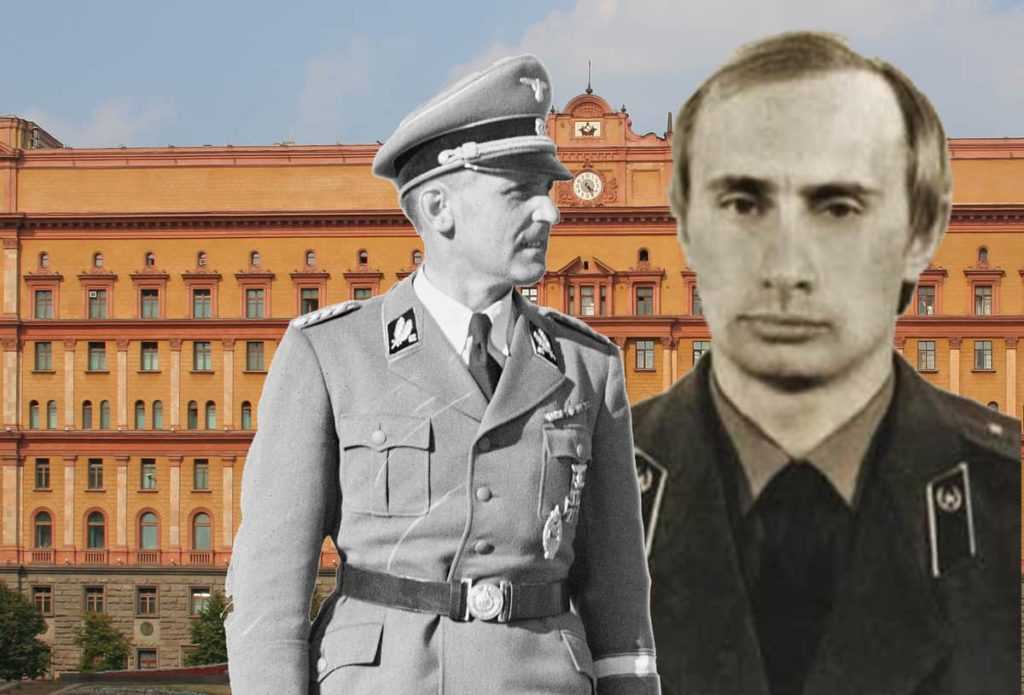Putin shares Gestapo chief’s admiration for the Bolshevik Cheka secret police

Russian President Vladimir Putin once again observed December 20 as the anniversary of his beloved Cheka, the “sword and shield” of the Bolshevik regime under Vladimir Lenin.
The germanophile Russian leader doesn’t want the world to remember that the Nazis used the Cheka as a prototype of the Gestapo.
Bolshevik repressive architecture impressed the efficient Nazis so much that SS Director Heinrich Himmler sent Gruppenfüherer Heinrich Müller to the Soviet Union to study the chekist system during the period of covert Nazi-Soviet military collaboration.
British historian Edward Crankshaw wrote that Müller borrowed from the Cheka – by that time known as the Joint State Political Directorate (OGPU) – to build Nazi Germany’s Secret State Police, known by the German abbreviation GESTAPO.
At the time, the Nazis and Soviets were working together on covert military technological developments. Müller visited the USSR to tour the chekist machinery and learn how to perfect what the Soviets had pioneered.
He replaced Reinhard Heydrich as GESTAPO chief in 1939, became an architect of the extermination of the Jews and others, and was one of the principal leaders to implement Hitler’s Final Solution.
Chekist revival
Putin is not known to be fan of Müller or the GESTAPO, of course, but he shares Müller’s admiration of Dzerzhinksy’s Cheka. He traces today’s Federal Security Service (FSB) as the lineal descendant of the KGB and Cheka.
As president over most of the past 20 years, Putin has revived Cheka traditions that Russia’s fractured democratic movement had tried to strip away. He restored the iconography of Feliks Dzerzhinsky, the notorious Cheka founder who ran a mass murder machine on an industrial scale. Dzerzhinsky and other Soviet founders designed a strategy of “extermination” of all opponents as an explicit means of taking absolute control of what they would build into the USSR.
Five years ago, Putin restored the Soviet-era name of an elite police unit back to “Dzerzhinsky Division.”
“In the past, the services worked for the Communist Party and the party ran the state,” Michelle Van Cleave, former head of US counterintelligence, told me in an interview a few years ago. “Now, the intelligence services are the state. That’s a very different government structure than we’re accustomed to.”
Cheka, the All-Russian Commission for Combating Counter-Revolution and Sabotage existed to smash any and all opposition to Vladimir Lenin’s creation of a utopian socialist society. “We represent in ourselves organized terror — this must be said very clearly,” proclaimed Dzerzhinsky.
Vladimir Putin is into that.
Brief Putin background
Putin was an undistinguished KGB man. He was not a “spymaster.” He served as a major in the KGB’s internal security chief directorate after his teenage years as a member of a predatory homosexual street gang prevented him from becoming a foreign intelligence officer. His only service “abroad” was as a liaison officer with the Stasi secret police in East Germany.
Following the Soviet collapse, Putin parlayed his street gang youth in his native Leningrad with his KGB training to run hard currency operations for his home town, since renamed St. Petersburg.
When president Boris Yeltsin recruited the city’s administratively effective leadership to run the Kremlin bureaucracy, Putin transferred to Moscow to run the Presidential Property Administration. From there, he became Minister of Security, then prime minister, finally persuading Yeltsin to resign on December 31, 1999, so he could be president.
- Caribbean proxies of Communist China have a decision to make - May 8, 2025
- CIA Director Casey’s alleged quote about disinformation is, itself, a falsehood - April 27, 2025
- Justice Dept. lawsuit puts US tech at China’s mercy - March 7, 2025
